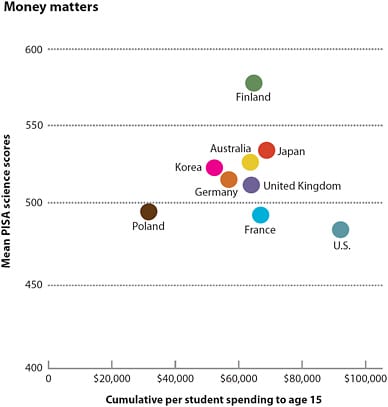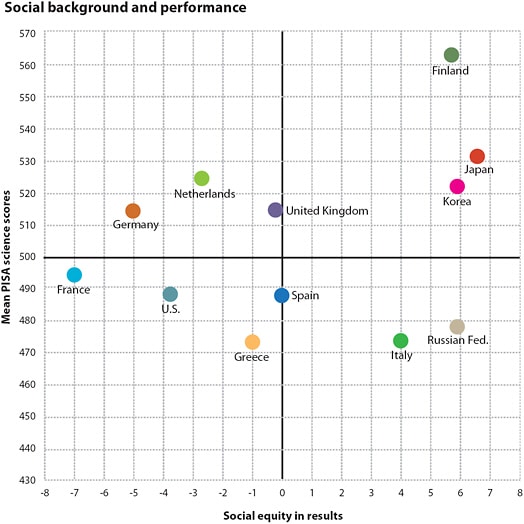The New Global Landscape of Educational Achievement
Some 10 years ago, we lived in a very different world where education systems tended to be inward-looking, where schools and education systems typically considered themselves to be unique, and where the perceived walls of language, culture, and political structure made it impossible for them to borrow policies and practices developed elsewhere.
Comparisons provide one way to break through some of these walls, and they have become a powerful instrument for policy reform and transformational change by allowing education systems to look at themselves in the light of the policies and performance of other systems. When education ministers meet at the Organization for Economic Cooperation and Development (OECD) these days, they begin almost every conversation with a comparative perspective. It seems that information is creating pressure to improve performance and that public accountability is now often more powerful than legislation, rules, and regulations.
U.S. labor market experts Frank Levy and Richard J. Murnane document how demand for various types of skills changed during the last three decades of the 20th century. Work involving routine manual input, the jobs of the typical factory worker, was down significantly. Non-routine manual work, jobs we do with our hands but in ways that are not so easily put into formal algorithms, was down too, albeit with much less change over recent years. We are not ready for machines to drive our buses or cut our hair.
This will not be news to most people, but many might be surprised to learn that the sharpest decline was for work requiring routine cognitive input, that is cognitive work that can easily be put into the form of algorithms and scripts. It is middle class white collar jobs that involve the application of routine knowledge that are most at threat today. And that is where schools still put a lot of their focus and what we value in multiple-choice accountability systems.
Levy and Murnane find that the skills that are easiest to teach and test are also the skills that are easiest to digitize, automate, and move offshore. The skills that will be more in demand in the future are expert thinking and complex communications, skills that require advanced high-quality education. The yardstick for success is no longer improvement by national standards, but the ability to prepare students to perform at the highest international standards.
Awareness of international standing has already motivated many countries to take dramatic action to reform their education systems, and the results are clearly visible in the data on educational achievement in the industrialized world during the past decade. Even more dramatic change is on the horizon as developing countries, particularly China and India, provide education to a larger share of their populations.
In recent years detailed data have become available about exactly how much students are learning in school, about the relative performance of advantaged and disadvantaged students, and about how schools in various countries allocate their resources. These data hold important lessons for all countries, but they should attract particular interest in the United States, which has long considered the quality of its education system to be a powerful asset but that now must face the reality that many countries are doing a better job of preparing future generations for the challenges to come.
All of the data presented in the following figures come from the OECD education database, which is available online. The test scores used in the figures are mean national scores for 15-year-olds on the science test of the 2006 Programme in International Student Assessment, a triennial survey that tested 400,000 students in 57 countries. Complete test results can be found in the OECD publication PISA 2006: Science Competencies for Tomorrow’s World.
College graduation rates
Each dot on this chart represents one country. The horizontal axis shows the college graduation rate, and the vertical axis shows you how much it costs to educate a graduate per year. Data for Australia andthe United Kingdon are not available for 1995.
The chart shows that in 1995 the United States had the highest proportion of young people earning college degrees, the highest level of spending per student.
By 2000 several countries had matched the U.S. level of college completion, and by 2005 the United States was no longer the world leader.
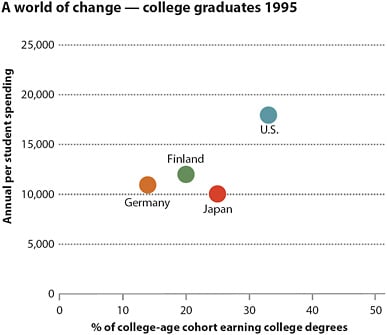
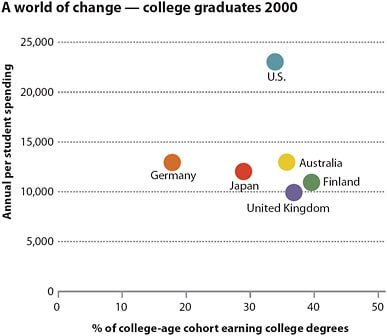

STEM degrees
In the fields of science, technology, engineering, and math, which are of particular importance for the economic strength of a country in a high technology economy, the position of the United States is even more precarious.
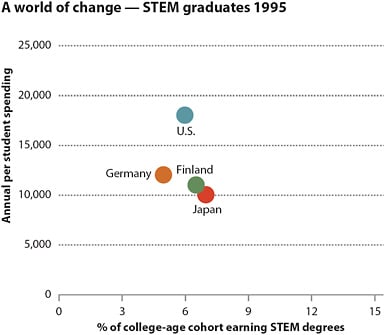
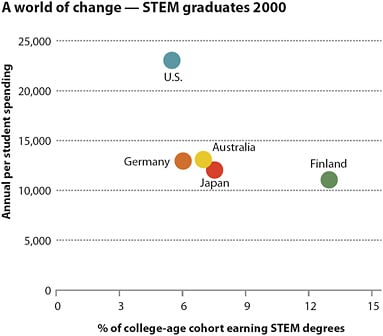

Quality and equity
When one looks at the distribution of student performance within each country, there are some countries where students from socioeconomically disadvantaged backgrounds trail far behind more privileged students and others where background has little influence on achievement. The social equality index was calculated by looking at the effect on socioeconomic status on test performance. Countries to the left had the largest gap between advantaged and disadvantaged students, and those on the right had relatively small differences across social classes.
Every country aspires to be in the upper right quadrant, where performance and equity are both strong. And no country wants to be in the lower left, where performance is low and the underprivileged trail far behind their peers. Whether it is better to have high performance at the price of large disparities or to minimize disparities at the price of mediocrity is subject to debate, but a few countries are demonstrating that it is not necessary to choose.
Countries such as Korea, Finland, and Japan have been able to combine high performance levels with an exceptionally moderate impact of social background on student performance.
Some defenders of the U.S. system argue that the disappointing performance of U.S. students is the result of factors outside the education system, such as the challenges that immigrant inflows pose to the education system. However, among the 41 countries that took part in the 2003 Programme for International Student Assessment (PISA), the United States ranks 10th in the proportion of 15-year-olds with an immigrant background, and all countries with larger immigrant shares outperformed the United States.

Future supply of high school and college graduates
What we have seen so far is just the beginning. The first and easy phase of globalization, the time that the industrialised world had to compete against only the China’s and India’s that offered a low-skilled, low-wage work force, is long gone. What we now see is that that countries like China or India are starting to deliver high skills at low costs at an ever-increasing pace, which will have powerful effects on the middle- and high-skills sectors in the industrialized countries. Although the quality of their education systems might not be producing graduates with the most advanced skills, many jobs require only second-tier skills.
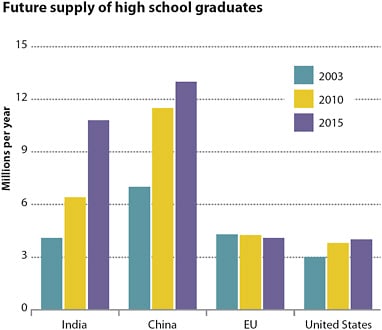
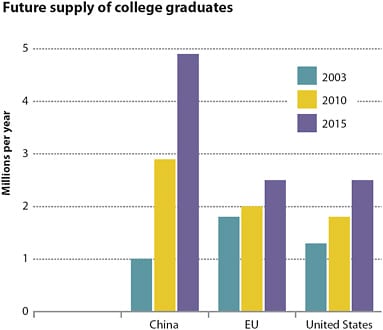
Money
Student performance cannot simply be tied to spending, at least not average spending. One must look beyond how much is spent to how it is spent. In international comparisons of primary school children the United States does relatively well, which given the country’s wealth, is what you would expect. The problem is that as they get older, U.S. students make less progress each year than their contemporaries in the best performing countries. This does not apply just to poor kids in poor neighbourhoods but to most kids in most neighborhoods. Some U.S. advocates for education reform see a need for even greater spending, but that will be a hard sell. In these times, sceptical citizens will not continue to invest precious tax dollars into a system that does not seem to be working. Nor will talented people flock into a profession where individuals are not rewarded for outstanding performance.
It is noteworthy that spending patterns in many of the world’s successful education systems are often markedly different. These countries invest the money where the challenges are greatest, and they put in place incentives and support systems that get the most talented school teachers into the most difficult classrooms. Successful countries such as Finland, Japan, and Korea emphasize more classroom time and higher teacher salaries, whereas the United States invests more heavily in reducing class size and limiting salaries.
